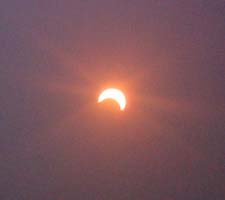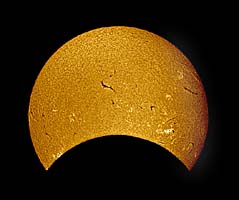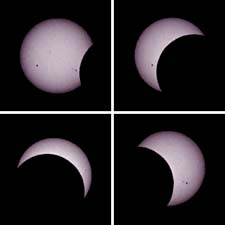
Nine-year-old Thor Fienberg captured this view of the partially eclipsed Sun on June 10th from his home near Los Angeles, California, using an eclipse shade placed over his father’s Sony digital camera. Among the 48 contiguous states, southern California experienced the greatest eclipse — 80% of the Sun's diameter was blocked by the Moon.
Courtesy Gregg D. Fienberg.
Monday's annular eclipse of the Sun (which occurred on Tuesday, June 11th, in Asia) attracted widespread attention, even though its long, narrow path of annularity passed over a largely uninhabited expanse of the Pacific Ocean. This is because the partial phases were visible over a vast area, including eastern Asia, Japan, northern Australia, and much of North America.
Since the eclipse occurred during the beginning of the monsoon season, members of the Philippine Astronomical Society braced themselves for cloudy skies on "E Day" morning. Observing from his home on the island of Cebu, Christopher Go was treated to a dazzling view of the crescent Sun at sunrise. "I was just happy that the sky was clear," he says, "because it was raining only two days before."
On Hawaii's Big Island the Hilo Astronomy Club, University of Hawaii, and Gemini Observatory hosted a daytime star party at the observatory's headquarters. "Although it was a gray day in Hilo, the Sun briefly broke through the overcast near the eclipse's maximum," says Peter Michaud of Gemini's public-information office. "The crowd of about 300 who had gathered was happy to get a glimpse of the partial eclipse during a brief respite from the rain."

This dramatic view of the crescent Sun in the light of the hydrogen atom was obtained by Jack Newton from Portal, Arizona, with a Meade 5-inch refractor, Pictor 1616XTE CCD camera, and two Coronado hydrogen-alpha filters in series.
Courtesy Jack Newton.
According to Sky & Telescope contributing editor Stephen James O'Meara, the Big Island had enjoyed about three consecutive weeks of clear weather prior to the eclipse. Fifteen minutes before the Moon took its first bite out of the Sun, however, thick clouds rolled in at O'Meara's site in the village of Volcano and produced a heavy downpour. He and his wife, Donna, drove around Kilauea, observing the eclipse through thinnings in the cloud cover. They didn't have to use their welder's-glass filters. "The clouds acted as a natural solar filter," says O'Meara.
Despite being closed in preparation for a major, three-year renovation, Southern California's venerable Griffith Observatory played host to more than 1,200 visitors for a picture-perfect public eclipse viewing. The observatory's rooftop Zeiss refractor and coelostat were supplemented on the front lawn by more than 25 telescopes brought by members of the Los Angeles Astronomical Society and the Los Angeles Sidewalk Astronomers. "All major radio and television networks and newspapers provided extensive coverage of the eclipse that darkened almost three-quarters of the Sun's disk," reports Griffith director and Sky & Telescope columnist Ed Krupp. "This is the last solar eclipse visible from Los Angeles until 2012 and the last public event at the observatory until it reopens in 2005."

Gregory Pyros recorded the partial eclipse from Newport Beach, California, with a Tele Vue-85 refractor and Nikon digital camera. He made one exposure every 60 seconds and stitched the sequence into an animation, which is available in two versions: 497-kilobyte MOV (QuickTime), 884-kilobyte AVI.
Courtesy Gregory Pyros.
"The view was fantastic!" exclaims comet discoverer and Sky & Telescope contributor David Levy, who observed with his wife, Wendee, from their backyard observatory in Vail, Arizona. "The best part was seeing a prominence right at the Sun's limb where the Moon was biting into the solar disk. And during maximum eclipse, where some 73 percent of the Sun was covered, we saw the most incredible lighting effects in the large, open land area to our south. Our surroundings just got dim, with sharp shadows. It was beautiful!"
Thousands more eclipse enthusiasts followed the event's progress over the Internet through a live webcast carried from the Pacific island of Tinian, in the Northern Mariana Islands. Here annularity lasted for 53 seconds, with the thin ring of the Sun 32° above the horizon. You can download a movie of the webcast at www.live-eclipse.org.
Preliminary reports arriving from Puerto Vallarta, Mexico, the last landfall along the eclipse path, indicate that observers there got clouded out.
The next solar eclipse — a total one — occurs on December 4th, when the Sun and Moon meet over southern Africa, the Indian Ocean, and southwestern Australia.
 0
0
Comments
You must be logged in to post a comment.